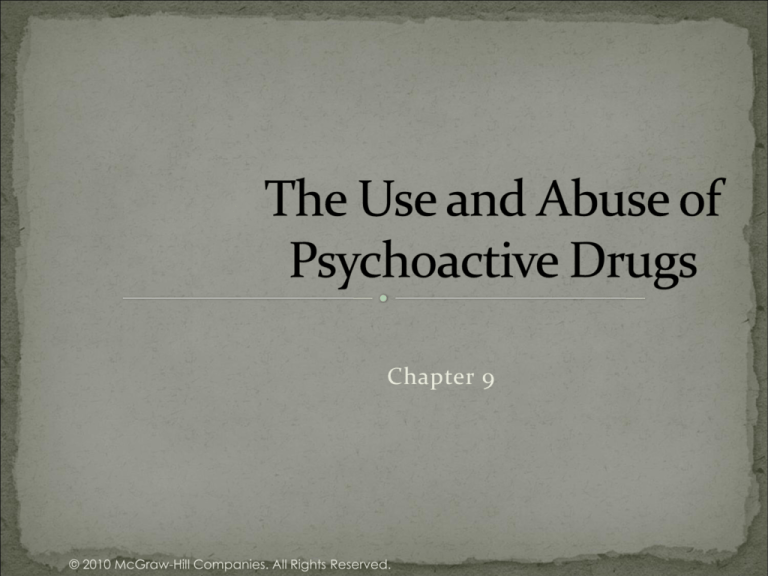
Chapter 9
© 2010 McGraw-Hill Companies. All Rights Reserved.
A drug which alters a person’s experiences or
consciousness
Can cause intoxications
A state in which sometimes unpredictable physical and
emotional changes occur.
2
© 2010 McGraw-Hill Companies. All Rights Reserved.
Habits that have gotten out of control, with a
resulting negative effect on a persons health.
Addiction is the habitual use of a drug produced
chemical changes in the user’s body.
Drug Addiction (four important characteristics)
Compulsive desire
2. Need to increase the dosage
3. Harmful effects to the individual
4. Harm to society
1.
Drug Habituation (habit)
3
© 2010 McGraw-Hill Companies. All Rights Reserved.
Reinforcement
Compulsion or Craving
Loss of Control
Escalation
Negative Consequences
4
© 2010 McGraw-Hill Companies. All Rights Reserved.
Often starts to bring pleasure or to avoid pain.
Harmless or even beneficial if done in moderation
Examples of addictive behaviors:
Gambling
Compulsive Exercising
Work Addiction
Sex and love addiction
Compulsive buying or shopping
Internet addiction
Characteristics of people with addition
5
© 2010 McGraw-Hill Companies. All Rights Reserved.
Drugs are chemicals other than food that are intended
to affect the structure or function of the body
Prescription medicines
Over-the-counter substances
Caffeine
Tobacco
Alcohol
Illegal substances
The Drug Tradition
6
© 2010 McGraw-Hill Companies. All Rights Reserved.
The APA’s Diagnostics and Statistical Manual of
Mental Disorders – authoritative reference
Abuse
APA definition
Failure to fulfill major responsibilities
Drug use in situations that are hazardous
Drug related legal problems
Drug use despite persistent social or interpersonal problems
Physically dependent may or may not present
7
© 2010 McGraw-Hill Companies. All Rights Reserved.
Substance dependence
1. Developing tolerance to the substance
2. Experiencing withdrawal
3. Taking in larger amounts
4. Expressing a persistent desire to cut down
5. Spending great deal of time obtaining
6. Giving up or reducing important activities
7. Continual usage even with recognition of a
problem
Diagnosed with at least 3 or more symptoms
during a 12-month period
8
© 2010 McGraw-Hill Companies. All Rights Reserved.
All income and education levels
All ethnic groups
All ages
Young people are at a higher risk
Males (Twice as likely)
Troubled adolescent
Thrill-seeker
Dysfunctional families
Peer group or family that accepts
Low Socioeconomical status
Dating young
9
© 2010 McGraw-Hill Companies. All Rights Reserved.
10
© 2010 McGraw-Hill Companies. All Rights Reserved.
Experiment
Escape
Reliance
Magnification of residence
11
© 2010 McGraw-Hill Companies. All Rights Reserved.
Psychological risks
Difficulty in controlling impulses
Strong need for excitement
Feelings of rejection
Hostility
Aggression
Anxiety
Mental illness
Dual (co-occurring disorders)
12
© 2010 McGraw-Hill Companies. All Rights Reserved.
Social Factors
Growing up in a family with drug abuse
Peer group
Poverty
13
© 2010 McGraw-Hill Companies. All Rights Reserved.
Intoxication
Side effects
Unknown Drug constituents
Risks associated with injection drug use
Legal consequences
14
© 2010 McGraw-Hill Companies. All Rights Reserved.
Changes in Brain chemistry
Drug factors:
Pharmacological properties
Dose-Response function
Time-action function
Drug use history
Method of use
User Factors
Social Factors
15
© 2010 McGraw-Hill Companies. All Rights Reserved.
16
© 2010 McGraw-Hill Companies. All Rights Reserved.
Psychoactive Drugs
© 2010 McGraw-Hill Companies. All Rights Reserved.
Chapter Nine
17
Opioids (narcotics)
Natural or synthetic
Opium, morphine, heroin, methadone, codeine,.
Hydrocodone, oxycodone, meperidine, and fentanly
Induce euphoria
Methods of administration
Injection, snorting, sniffing or smoking
Symptoms of overdose
18
© 2010 McGraw-Hill Companies. All Rights Reserved.
Central Nervous System Depressants
Slow down the overall activity of the CNS
Sedative-hypnotics
Types
Effects
Effects on the body
Medical uses
From use to abuse
Overdosing
19
© 2010 McGraw-Hill Companies. All Rights Reserved.
Speed up the activity of the nervous or muscular
system
Cocaine
Methods of use
Effects
Abuse and Dependence
Use during pregnancy
20
© 2010 McGraw-Hill Companies. All Rights Reserved.
Amphetamines
Effects
From use to abuse
State dependence
Dependence
psychosis
Ritalin
Ephedrine
Caffeine
21
© 2010 McGraw-Hill Companies. All Rights Reserved.
22
© 2010 McGraw-Hill Companies. All Rights Reserved.
Cannabis Sativa
THC (tetrahydrocannabinol)
Short term effects and uses
Depersonalization
Long-term effects and uses
Respiratory damage
Dependence
23
© 2010 McGraw-Hill Companies. All Rights Reserved.
Altered state of consciousness, perceptions, feelings
and thoughts
LSD, Mascaline, DMT, MDMA, Ketamine, PCP (angel
dust), and certain mushrooms
Altered states of consciousness
Impact on proprioception
Synesthia
Flashbacks
24
© 2010 McGraw-Hill Companies. All Rights Reserved.
Nearly all inhalants produce effects similar to those of
anesthetics, slow down the bodies functions
Volatile solvents
Nitrates
Anesthetics
Methods of use
Sniffing
Snorting
“Bagging”
“Huffing”
25
© 2010 McGraw-Hill Companies. All Rights Reserved.
Drug research
Drugs, society, and families
Legalization
Drug Testing
26
© 2010 McGraw-Hill Companies. All Rights Reserved.
Medication-assisted treatment
Drug substitution
Treatment centers
Self-help groups and peer counseling
AA
NA
Harm reduction strategies
Codependency
27
© 2010 McGraw-Hill Companies. All Rights Reserved.
Governmental attempts
Anti-drug education programs
Indirect approaches
Young people’s self-esteem
Improve academic skills
Increase recreational opportunities
Direct approaches
Information about the adverse effects
Peer pressure resistance
28
© 2010 McGraw-Hill Companies. All Rights Reserved.
Issues
What are the risks involved?
Is using the drug compatible with your goals?
What are your ethical beliefs about drug use?
What are the financial costs?
Are you trying to solve deeper problem?
29
© 2010 McGraw-Hill Companies. All Rights Reserved.
Bored?
Stressed?
Shy or lonely?
Feeling low on self-esteem?
Depressed or anxious?
Apathetic or lethargic?
Searching for meaning?
Afraid to say no?
Still feeling peer pressure?
30
© 2010 McGraw-Hill Companies. All Rights Reserved.
Chapter 9
© 2010 McGraw-Hill Companies. All Rights Reserved.






